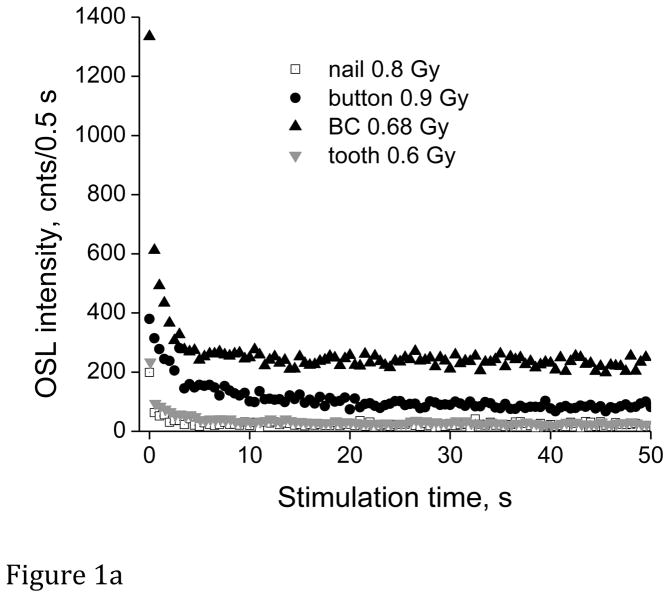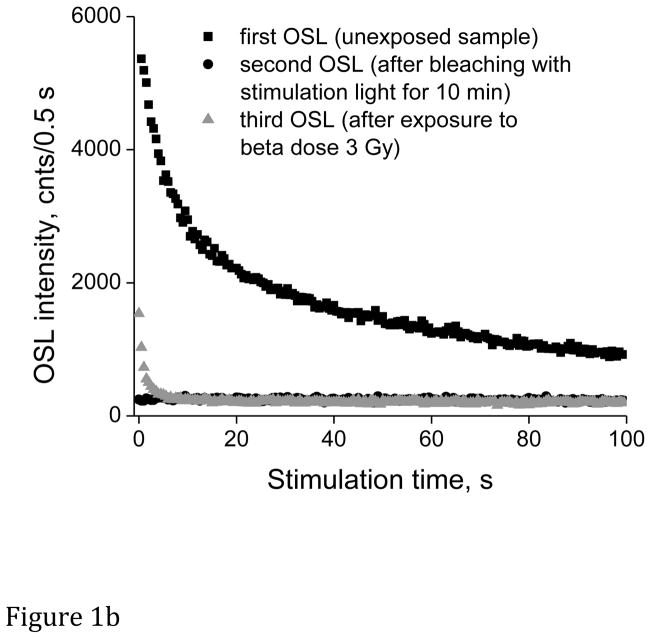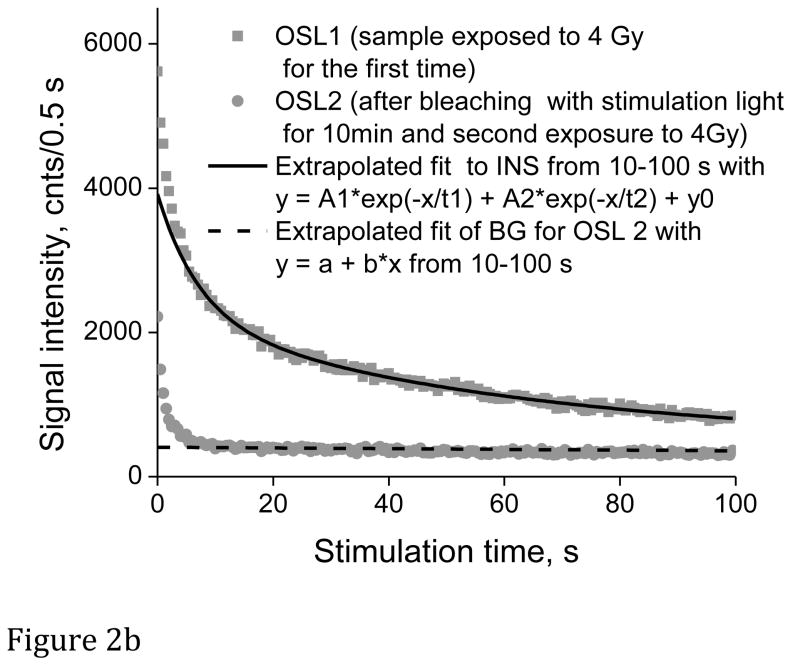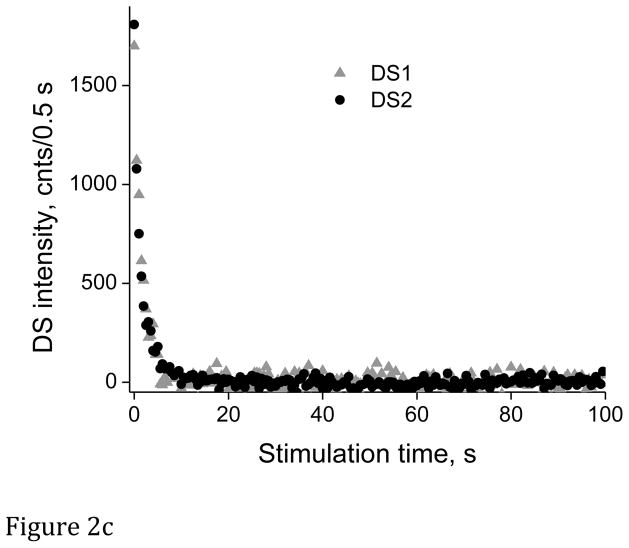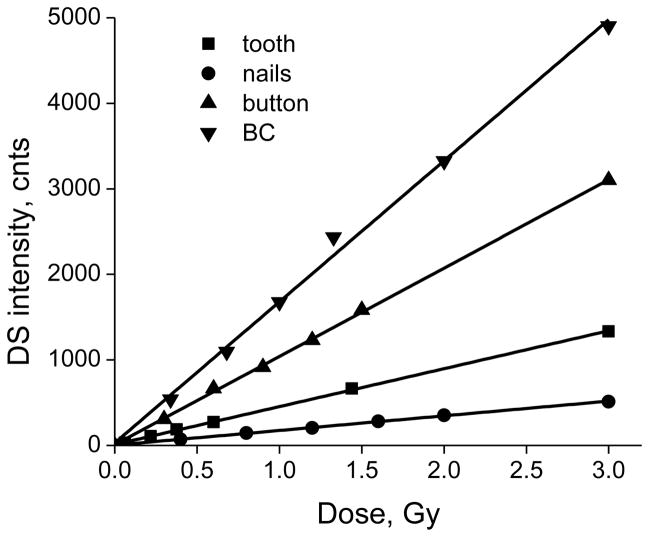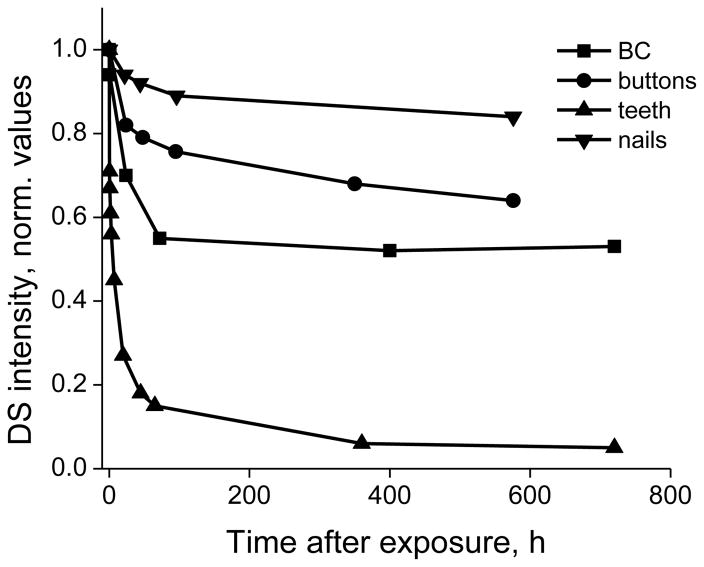Abstract
Several materials were tested as possible individual emergency dosimeters using Optically Stimulated Luminescence (OSL) as means to assess the exposure. Materials investigated included human nails, business cards and plastic buttons. The OSL properties of these materials were studied in comparison with those of teeth. Most samples revealed OSL signals only after exposure to ionizing radiation; some samples of business cards, however, displayed a strong initial “native” signal (i.e. existing in the samples prior to irradiation). The sensitivity (minimum measurable dose) of the samples was found to vary significantly from sample to sample of the same material and was in the range from several tens of mGy to a few dozens of Gy. The dose response curves were linear for doses below 10 Gy. Fading of the OSL signals was estimated for different lenghts of times and found to be ~95%, 45%, 30% and 15% for samples of teeth, business cards, buttons and nails, respectively, following storage at room temperature in the dark for a period of 3 weeks after exposure. For samples stored under routine laboratory light, fading was much faster and the radiation-induced signals almost disappeared after a few hours of such illumination. It was concluded that the tested materials could be used in triage situations to detect and estimate the possible overexposure of individuals if the measurements can be performed soon enough after exposure.
Keywords: OSL dosimeter, individual emergency dosimetry, teeth, nails, business cards, plastic buttons
1. Introduction
Over the last several years, Optically Stimulated Luminescence (OSL) has been examined for its potential in emergency dosimetry using different materials as possible personal dosimeters. The most promising of the tested materials appear to be teeth and dental ceramics (Sholom et al., 2011; DeWitt et al., 2010; Veronese et al., 2010), electronic components from mobile phones and portable electronic devices (Bassinet et al., 2010; Ingrid et al., 2008; Woda et al., 2010), and chip modules from ID and telephone cards (Woda & Spöttl, 2009; Mathur et al., 2007; Göksu, 2003). Also some other materials demonstrated high OSL sensitivity to ionizing radiation, e.g. gypsum wallboard (Thompson et al., 2010) and household salt (Bernhardsson et al., 2009), but they generally cannot be used for estimation of doses to individuals.
In the present study, some other materials have been tested for possible use as personal emergency OSL dosimeters. Materials examined included human nails (both from fingers and toes), personal business cards, and plastic buttons. We compare the OSL response of these materials with those of teeth in order to assess their dosimetric properties and their potential for use in triage applications following a radiation accident or other mass exposure event.
2. Materials and Methods
Nail clippings (fingers and toes) as well as teeth extracted during routine dental practice were tested as possible biological OSL dosimeters. Business cards from different commercial sources as well as miscellaneous buttons from local stores were investigated as potential OSL dosimeters. The total number of samples tested was several hundred, including approximately 140 teeth, 70 business cards from three internet vendors and private collections, 50 samples of nails from 7 different individuals, and 40 plastic buttons from 3 manufacturers and also from private collections. Samples were studied on a specially constructed OSL system that allows for analysis of large samples. Light emitting diodes (LEDs) of different wavelengths were tested as potential sources of stimulation light; the OSL signal was detected with a photon counter after passing through a Hoya U-340 filter to a photomultiplier tube. Exposure to ionizing radiation was conducted with a 90Sr/90Y beta source which delivers a local dose as a surrogate to gamma radiation which would more likely be encountered in emergency scenarios.
The following basic effects were examined: (1) dose-response relationships; (2) sensitivity to ionizing radiation; (3) variability between different samples; (4) fading of OSL after radiation exposure.
3. Results and Discussion
3.1 General description of OSL curves
OSL curves for some representative samples recorded immediately after samples exposure are shown in Figure 1 for two different types of samples. Samples of the first type are illustrated in Figure 1a; only OSL curves of exposed samples are shown since there was no discernable signal above the background noise from unexposed samples. Samples of the second type (from some business cards) show an inherent (a non-radiological) “native OSL” signal (INS); see first OSL curve in Figure 1b. Although the origin of this signal is not clear, it can be removed by exposure to stimulation light for 10 minutes (see the “second OSL” signal in Figure 1b). Also shown for comparison is the “third OSL” signal from such a sample recorded after sample exposure to 3 Gy of beta irradiation.
Figure 1.
Examples of OSL curves for teeth, nails, business cards (BC), and plastic buttons recorded immediately after samples exposure. a – OSL curves from samples without an inherent native signal (only OSL curves of exposed samples are shown for different materials because corresponding unexposed samples displayed no signal above flat noisy background); b – OSL curves from a business card sample with an initial native signal. Three different OSL curves are shown: the first is the OSL curve in an initial unexposed sample; the second is the OSL curve from the same sample but following bleaching by stimulation light for 10 min; the third is the OSL from the same sample after bleaching and exposure to a beta-dose of 3 Gy.
3.2 Evaluation of the dosimetric signal
For samples without the INS signal, the signal used for dosimetry (“dosimetric signal”, DS) was calculated as the difference between the OSL signal integrated for the beginning part (0–1 s) of the OSL curve and a corresponding background signal (BG) averaged over the flat part (45–50 s) of the OSL curve, see Figure 2a. The minimum measurable dose (MMD) in Figure 2a was evaluated as that dose for which DS is three times the standard deviation of the background. Values of MMD depended on many parameters including wavelengths of stimulation lights. Minimal values were observed with Blue LEDs (460–490 nm) in case of nails, business cards and buttons and Cyan LEDs (490–520 nm) in case of teeth. For those samples with native signal, INS (Figure 2b,c), two OSL curves were recorded. The first (OSL1) is for the sample with the unknown dose (a beta dose of 4 Gy was administered to the sample shown in Figure 2b as a simulation of the “unknown dose”); the second (OSL2) is for the same sample after it was bleached by stimulation light for 10 min and then re-irradiated with a test dose (another 4 Gy beta dose was chosen for the test dose in the current case.) The OSL2 signal was assumed to be of the same shape as the dosimetric signal in OSL1. Examination of Figure 2 shows that the OSL2 signal decays quickly, over the first approximately 10 s. In contrast, the OSL1 signal, containing the native signal, decays over a much longer period. Therefore, with the assumption that the dosimetric signal (DS) in OSL1 decays as quickly as OSL2, we fitted the long-decay section of the OSL1 signal (10s – 100s; i.e. that part free from the DS signal) with a bi-exponential function to obtain the shape of the native signal (Figure 2b). The fitting result was extrapolated over the whole range to zero stimulation time and then subtracted from OSL1. The resulting difference is assumed to be the DS component of OSL1. The correctness of this procedure can be tested by comparing the DS determined in this way from OSL1 with the OSL2 curve, as is shown in Figure 2c. The coincidence is satisfactory.
Figure 2.
Evaluation of the dosimetric signal in samples without (plot a) and with a native signal (INS) (plots b-c). For samples without INS (plot a), the OSL signal is integrated over the beginning part (0–1 s) of the curve and the corresponding background signal is then subtracted. Values of signals were: OSL = 1113+18, BG = 335+18, noise = 18; DS = OSL -BG = 778+26, MMD = 0.21 Gy. For samples with INS, the native signal is determined by fitting the OSL curve for the range 10–100 s of stimulation time (which is free from the dosimetric signal, DS). The fitted INS is then extrapolated to zero over the whole range of stimulation time and is subtracted from the measured OSL to obtain the DS. The validity of the procedure can be tested by comparing the OSL curve after bleaching and a second exposure of the sample to the same dose (curve “OSL2” in plot b). Comparison of the DS components only for the first and second 4-Gy OSL is shown in plot c.
3.3 Dose-response curves and radiation sensitivity
Dosimetric signals were evaluated for all the samples that we studied for a range of applied doses using the above-described procedures and the resulting dose response curves were plotted. Representative examples are shown in Figure 3. The dose-responses were found to be linear in the tested dose range (below 10 Gy) for all the materials studied. Each material demonstrated significant variability of radiation sensitivity between samples of the same type. The variability among nails, business cards and buttons was each greater than the variability among teeth. As a rule, only business cards made from coated card stock displayed radiation-induced OSL. In most cases, such “radiation-sensitive” cards were distinguishable by eye from “radiation-insensitive” ones by the coating or surface finish.
Figure 3.
Dose response curves for some representative samples of teeth, nails, business cards and plastic buttons.
All buttons may be divided into “sensitive” and “insensitive” with respect to ionizing radiation. Only 20% of the buttons from our collection were radiation-sensitive though there was no obvious visual difference between sensitive and insensitive buttons.
The most curious situation was found with nails. Detailed experiments revealed that only a few pieces from all the nail clippings collected contributed to the OSL signal after sexposure. If these pieces are removed, the OSL signal was significantly reduced. It was also found that simple mechanical cleaning of these sensitive pieces with paper napkins resulted in the disappearance of the dosimetric OSL signal. It was concluded that the OSL from nail samples is emitted mainly, not by the nail tissue, but rather by impurities such as small particles of sand, on the nails’ surfaces. This complicates the possibility of using OSL for dosimetry with nails.
3.4 Fading
Figure 4 demonstrates the fading of the dosimetric signal from samples stored in the dark at room temperature. In general, the fading was the fastest for teeth and slowest for nails with some intermediate values for buttons and business cards. For example, the reduction of the dosimetric signal was about 95%, 45%, 30% and 15% for corresponding samples of teeth, business cards, buttons and nails stored in the dark over a period of 3 weeks following exposure. The fading was much faster for samples stored under routine laboratory light (white fluorescent light with irradiance about 0.35 mW/cm2) and the radiation-induced signals almost disappeared after a few hours of such illumination. As expected for OSL, ambient light very quickly destroys the OSL signals in irradiated samples and only samples that have been stored in the dark may be potentially suitable for dose determination with the OSL technique. Curves similar to those shown in Figure 4 should be used for correction of the signal due to fading in such samples.
Figure 4.
Fading of OSL signals from samples stored in the dark at room temperature.
The influence of fading on the accuracy of the dose determination can be seen from the data in Table 1 where values of the MMD are given for samples tested at two specific times: immediately and 24 h after exposure. After fading, the MMD is significantly greater, as is to be expected. The specimens most sensitive to fading are teeth; to obtain a usable signal they should be measured within 24 h after exposure. Nails and business cards can keep the exposure information for longer times. However, this may turn out to be an advantage only for business cards because nails are part of a living organism and may change their dosimetric properties and possible surface contamination with time.
Table 1.
Minimum Measurable Doses (MMD) determined for two specific measurement times: immediately after samples exposure and 24 h after exposure
| Teeth | Nails | Business Cards1 | Buttons2 | |
|---|---|---|---|---|
| MMD (Gy); immediate | 0.03 – 1.5 | 0.1 – 5.0 | 0.04 –1.0 | 0.03 – 0.15 |
| MMD (Gy); after 24 hrs | 0.15 – 8.0 | 0.2 –10 | 0.05 – 2.0 | 0.09 – 0.3 |
25–30% of samples
20–25% of samples
4. Conclusions
Four commonly found materials, including two biomaterials, were examined for potential use as triage or emergency dosimeters, using OSL. Of the four materials (human teeth, human fingernails and toenails, business cards, and buttons), all demonstrated the potential to store signals that could be used to estimate doses small enough to be of value for emergency dosimetry. Minimum measurable doses ranged from 0.03 Gy to 10 Gy, depending on sample type and elapsed time between exposure and measurement.
All four materials exhibited considerable sensitivity variation from sample to sample suggesting that some type of normalization technique is needed to account for the variation. All the materials also exhibited significant fading of the radiation-induced OSL signal which would require a correction to estimate the actual dose received. Most materials will only be of use as triage dosimeters using the OSL technique if they can be analyzed within a few days after the exposure.
Of the materials tested, nails, business cards and buttons can be examined in the laboratory using sensitive OSL detection systems. Furthermore, the sample-to-sample variability in sensitivity may be normalized using a test dose from an external source of radiation. Use of human teeth as dosimeters, however, presents greater challenges. OSL analysis will require the development of an in vivo measurement examination technique (e.g. via fiber optics) as well as a normalization technique that does not require irradiation of the sample.
Acknowledgments
This work was supported by the Intra-Agency agreement between the National Institute of Allergy and Infectious Diseases and the National Cancer Institute, NIAID agreement #Y2-Al-5077 and NCI agreement #Y3-CO-5117.
Footnotes
Publisher's Disclaimer: This is a PDF file of an unedited manuscript that has been accepted for publication. As a service to our customers we are providing this early version of the manuscript. The manuscript will undergo copyediting, typesetting, and review of the resulting proof before it is published in its final citable form. Please note that during the production process errors may be discovered which could affect the content, and all legal disclaimers that apply to the journal pertain.
References
- Bassinet C, Trompier F, Clairand I. Radiation accident dosimetry on electronic components by OSL. Health Phys. 2010;98:440–445. doi: 10.1097/01.HP.0000346335.56701.93. [DOI] [PubMed] [Google Scholar]
- Bernhardsson C, Christiansson M, Mattsson S, Rääf CL. Household salt as a retrospective dosemeter using optically stimulated luminescence. Radiat Environ Biophys. 2009;48:21–28. doi: 10.1007/s00411-008-0191-y. [DOI] [PubMed] [Google Scholar]
- DeWitt R, Klein DM, Yukihara EG, Simon SL, McKeever SWS. Optically Stimulated Luminescence (OSL) of Tooth Enamel and Its Potential Use in Post-Radiation Exposure Triage. Health Phys. 2010;98:432–439. doi: 10.1097/01.HP.0000347997.57654.17. [DOI] [PMC free article] [PubMed] [Google Scholar]
- Göksu HY. Telephone chip-cards as individual dosemeters. Radiat Meas. 2003;37:617–620. [Google Scholar]
- Inrig EL, Godfrey-Smith DI, Khanna S. Optically stimulated luminescence of electronic components for forensic, retrospective, and accident dosimetry. Radiat Meas. 2008;43:726–730. [Google Scholar]
- Mathur VK, Barkyoumb JH, Yukihara EG, Göksu HY. Radiation sensitivity of memory chip module of an ID card. Radiat Meas. 2007;42:43–48. [Google Scholar]
- Sholom S, DeWitt R, Simon SL, Bouville A, McKeever SWS. Emergency Dose Estimation Using Optically Stimulated Luminescence from Human Tooth Enamel, Submitted to Radiat. Meas. 2011 doi: 10.1016/j.radmeas.2011.03.008. [DOI] [PMC free article] [PubMed] [Google Scholar]
- Thompson JW, Burdette KE, Inrig EL, DeWitt R, Mistry R, Rink WJ, Boreham DR. Optically stimulated luminescence dosimetry with gypsum wallboard (drywall) Radiat Prot Dos. 2010;141:1–9. doi: 10.1093/rpd/ncq143. [DOI] [PubMed] [Google Scholar]
- Veronese I, Galli A, Cantone MC, Martini M, Vernizzi F, Guzzi G. Study of TSL and OSL properties of dental ceramics for accidental dosimetry applications. Radiat Meas. 2010;45:35–41. [Google Scholar]
- Woda C, Greilich S, Beerten K. On the OSL curve shape and preheat treatment of electronic components from portable electronic devices. Radiat Meas. 2010;45:746–748. [Google Scholar]
- Woda C, Spöttl T. On the use of OSL of wire-bond chip card modules for retrospective and accident dosimetry. Radiat Meas. 2009;44:548–553. [Google Scholar]



